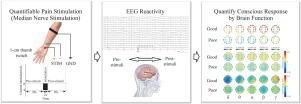Journal of Neuroscience Methods ( IF 2.7 ) Pub Date : 2020-06-18 , DOI: 10.1016/j.jneumeth.2020.108812 Weibi Chen 1 , Gang Liu 1 , Yingying Su 1 , Yan Zhang 1 , Yicong Lin 1 , Mengdi Jiang 1 , Huijin Huang 1 , Guoping Ren 2 , Jiaqing Yan 3

|
Background
Electroencephalographic reactivity (EEG-R) is a major predictor of outcome in comatose patients; however, the inter-rater reliability is limited due to the lack of homogeneous stimuli and quantitative interpretation.
New Methods
EEG-R testing was employed in comatose patients by quantifiable electrical stimulation. Reactivity at different frequency bands was computed as the difference between pre- and post-stimulations in power spectra and connectivity function (including magnitude squared coherence and transfer entropy). The clinical outcomes were dichotomized as good and poor according to the recovery of consciousness. Signal discrimination of EEG-R was compared between the two groups.
Results
A total of 18 patients (43%) regained consciousness at a 3-month follow-up. In the patients who regained consciousness, the EEG power increased significantly (P < 0.05) at the Alpha and Beta frequency bands after stimulation as compared to those with no behavioral awakening. Also, connectivity enhancement (including linear and nonlinear analysis) in the Beta and Gamma bands and connectivity decrease (nonlinear transfer entropy analysis) in the Delta band after stimulus were observed commonly in the good outcome group.
Comparison with Existing Method(s)
In this study, the combined use of quantifiable stimulation and quantitative analysis shed new light on differentiating brain responses in comatose patients with good and poor outcomes as well as exploring the nature of EEG changes concerning the recovery of consciousness.
Conclusions
The combination of quantifiable electrical stimulation and quantitative analysis with spectral power and connectivity for the EEG-R may be a promising method to predict the outcome of comatose patients.
中文翻译:

昏迷患者的脑电信号随预后不同而变化:脑电图反应性的定量方法。
背景
脑电图反应性(EEG-R)是昏迷患者预后的主要预测指标。但是,由于缺乏同质刺激和定量解释,评估者之间的可靠性受到限制。
新方法
通过定量的电刺激对昏迷患者进行了EEG-R测试。计算不同频段的反应性,作为功率谱刺激前后的差异和连通性函数(包括强度平方相干性和传递熵)。根据意识的恢复,将临床结果分为好和坏。在两组之间比较了EEG-R的信号判别。
结果
在3个月的随访中,共有18例患者(43%)恢复了意识。与没有行为觉醒的患者相比,在恢复意识的患者中,在刺激后,Alpha和Beta频段的脑电图功率显着增加(P <0.05)。同样,在良好结果组中,通常观察到在刺激后,β和Gamma波段的连通性增强(包括线性和非线性分析),而Delta波段的连通性下降(非线性转移熵分析)。
与现有方法的比较
在这项研究中,可量化的刺激和定量分析的结合使用为区分昏迷的好转和差预后的患者的脑反应提供了新的思路,并探索了与意识恢复有关的脑电图改变的性质。
结论
EEG-R的可量化电刺激和定量分析与频谱功率和连通性的结合可能是预测昏迷患者预后的有前途的方法。











































 京公网安备 11010802027423号
京公网安备 11010802027423号